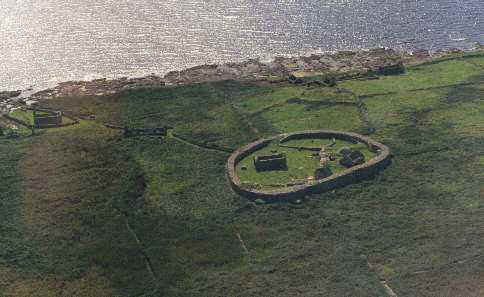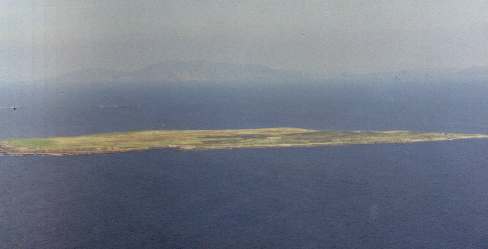 Welcome to Inishmurray, a small island off the coast of County Sligo in Northwest
Ireland, four and a half miles from the nearest point on the mainland shore.
Welcome to Inishmurray, a small island off the coast of County Sligo in Northwest
Ireland, four and a half miles from the nearest point on the mainland shore. An Ancient Monastic Island on the Wild West Coast of Ireland
By Patrick Heraughty
(Click on the monastery to see inside)
 Welcome to Inishmurray, a small island off the coast of County Sligo in Northwest
Ireland, four and a half miles from the nearest point on the mainland shore.
Welcome to Inishmurray, a small island off the coast of County Sligo in Northwest
Ireland, four and a half miles from the nearest point on the mainland shore.
Inhabited for centuries, but now deserted by man Inishmurray today contains the most complete remains of an early Irish monastic settlement as well as the ruins of its nineteenth century houses.
Inishmurray was continuously inhabited from the sixth century, although the population waxed and waned through the years.
And it is not unreasonable to assume that there were people on the island before this, perhaps hundreds of years before, since Inishmurray would have been an ideal location for the Formorian sea marauders who once lived on Ireland's offshore islands.
Two locations on the island suggest a prehistoric settlement, but definitive proof awaits future excavation.
In 1880, Inishmurray boasted a population of 102 persons. But this had fallen to forty-six by the time of its evacuation in 1948 when the relative affluence of life on the mainland and in towns and cities, from nearby Sligo to London and Birmingham, drew people away.
 Inishmurray is low lying, rising only seventy feet above sea level at its highest
point on the western end and sloping to sea level on the east. It is only a mile long and
a half a mile across at its widest part and resembles a bay leaf in shape, with Rue Point
the point of the leaf and Kinavally the foot stalk.
Inishmurray is low lying, rising only seventy feet above sea level at its highest
point on the western end and sloping to sea level on the east. It is only a mile long and
a half a mile across at its widest part and resembles a bay leaf in shape, with Rue Point
the point of the leaf and Kinavally the foot stalk.
Of its 223 acres, only sixty-three are good arable land. The rest is shallow peat. Indeed, in some places, it is subsoil from which the peat has been stripped.
Most of Ireland, is limestone country. But Inishmurray and its submerged rocks lying both east and west of the island are sandstone. This suggests that the island is the highest remaining point of an arm of land that once extended from Mullaghmore on the mainland to the west of Inishmurray, to became an island around 7,000 B.C. when a notable rise in sea levels the world over resulted in the submerging of much coastal land. At the western end of the island long, deep inlets of sea form natural harbours and excellent swimming pools. They are known as 'Classeys' from the Irish Claisdhe meaning furrow.
Only at Classiebawn at Mullaghmore on the mainland is this word used to describe a sea inlet.
The island is poor in natural resources. The flora is that found in any peaty, coastal area; soil-sea pinks in profusion, tormentil, bog cotton, buttercups, orchids, bluebells, daisies, heathers, and such. Centaurey blooms profusely in August and was known by the Islanders as "the Blessed Virgin flower", probably because of the occurrence of the feast of the Immaculate Conception on August 15. The primrose does not grow there, and there are no trees or shrubs. The blackberry bush is scarce; at blackberry times one had to be up at dawn to make a worthwhile collection. There are no lakes on the island, just three small pools in places where the turf has been removed.
There are few animals on the island. Not even rats live there, indeed the clay of the island was believed to be fatal to rats. Mainland farmers often got clay from Inishmurray to spread about their farmland to kill rats. The great silence on its effect, however, makes for suspicion of its efficacy. Quite probably no rats ever got to the island because they would scramble out of the small boats before they left the mainland.
There are mice, but these did not arrive until someone had stabbed a neighbour's horse and in retribution the drops of blood turned into mice, or so the islanders said.
The most unusual animal is a small lizard known as mankeeper which reputedly jumps into the mouth of anyone who stoops to drink water out of a well. Seals are found on the island's rocky shores and a variety of birds visit its barren surface. My grandfather had a pet seal for many years. He made a shelter for it in a small rock cave near the high water mark. It was an excellent weather forecaster as it always left and went out into deep waters twenty-four hours or more before a storm arose. Today Inishmurray is a bird sanctuary, but there has been a marked change in the bird population since the islanders left. Most of the birds which frequented the island have almost disappeared. The lapwing, once the most common bird, is now a rarity. Rock dippers are now also very few. Crows and blackbirds are not found on the island, although migrant thrushes do come seasonally, as do swallows, swifts, and corncrakes in large numbers. The preponderance today consists of sea birds, with a marked increase in gulls. Shell ducks and eider ducks have become common since the islanders left, and Inishmurray is now the southern-most station of the eider duck.
Access to Inishmurray was always unpredictable. There was no enclosed harbour and all boats had to be taken out of the water and stowed safely on the rocks out of the sea's reach. As a result, the islanders used small boats of twenty-eight feet or less. In winter, contact with the mainland might be severed for up to six weeks. Even in summer, a week's isolation was not unusual. The one road on the island was built in the later part of the nineteenth century. It runs from the eastern to the western entrances of the peaty common which covers most of the island surface. The twelve remaining houses stand on the southern part of this road and face due south. The roofs were originally of thatch but subsequent rooms added to the original structures were slate-roofed. Due to the wet conditions and the use of straw as the thatching material the roofs were freshly thatched about every third year.
During the last century and until the island's evacuation, the main economic activity on Inishmurray was the making of illegal whiskey. It was sold to retailers on the mainland.
Fishing, especially for fish that could be cured and later sold to the mainland, ranked next. Getting freshly caught fish to market on time was always a problem. Edible sea weed like Crannach (often miscalled "Dilisk" in the shops) and Carrigeen Moss, known on Inishmurray as "Fudar", was collected, dried, and sold in Sligo Town.
Farming was at subsistence level, with the potential cash bonus of one to four young cattle for sale each year. The families on two holdings were also able to produce enough homemade butter and surplus eggs to sell these to mainland shops.
Though isolated and poor, Inishmurray was a rich and satisfying environment in which to live. It was a close community in which people were friendly and helpful. Though young people might tease or make fun of older persons, they were always kind. No one was allowed to be in want and a helping hand always reached out when someone was old or ill. For example, a group of younger people would gather without being asked to save their hay, cut their turf, plant their potatoes, or offer to transport their cattle to the mainland.
Young and old alike gathered together for festive occasions and to play games or listen to Crimley, the island wit, tell saga tales and stories of long ago.
At a dance the older people would sit around to comment on and encourage the young. Fellowship and community spirit were strong. Indeed, islanders often felt lonely on trips to the mainland and longed to return home.
As one of the few islanders remaining who lived to adulthood on Inishmurray, I feel an obligation to write what I can while there are still others who can help and correct me. I have used archival material and published archaeological and historical accounts, but there is still much historical and professional archaeological research to be done.
Times Past on Inismurray by Albert Bree
Life on Inishmurray by Florrie Brady
Faeries on Inismurray and the strange tale of the disappearing island